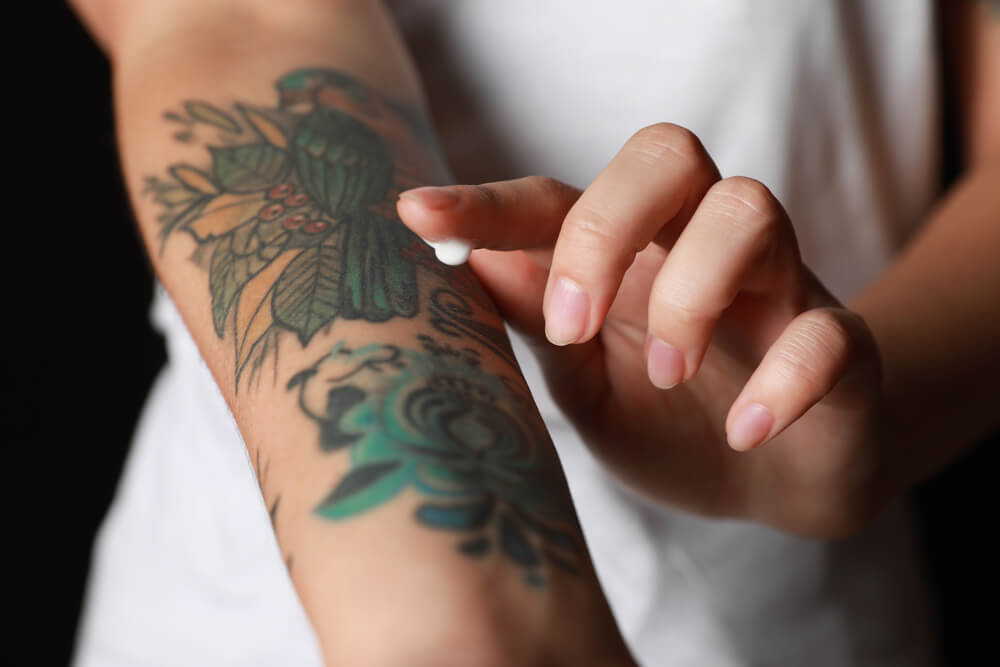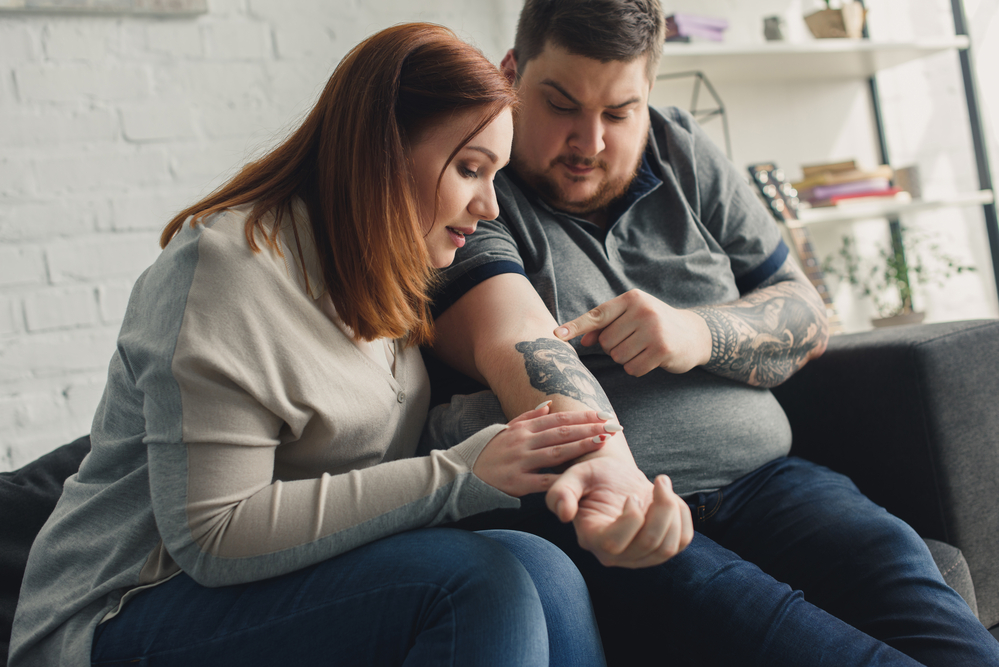So, you’ve just got your new tattoo and are eager to show it off to the world. But hold on – before you unveil your masterpiece, it’s crucial to understand the healing process and how to take care of your fresh ink.
This comprehensive guide will walk you through each stage of the tattoo healing timeline, debunk common myths, and provide essential aftercare tips to ensure your body art remains vibrant and healthy for years to come. One key question we will address is “How long does a tattoo take to heal?” so that you can be well-informed and prepared.
Key Takeaways
- Tattoo healing typically spans two to six months, depending on factors such as size, placement, and pigmentation.
- Proper aftercare is essential for successful tattoo healing. This includes cleaning and moisturizing regularly, protecting the tattoo from friction/sun exposure and recognizing any complications.
- Tattoo artists play a crucial role in providing guidance on proper aftercare instructions to ensure successful healing results.
The Tattoo Healing Timeline

Understanding the healing process of tattoos is important for looking after your brand-new ink. A tattoo heals on its exterior within two to three weeks, yet might take as long as half a year for complete recovery.
Elements such as area and size of the design, use of black or grey pigments, lifestyle habits & personal well-being all play into how well you heal from getting inked up.
Below we’ll delve deeper into each step included in this so-called ‘tattoo healing stage’.
Initial 24-48 Hours
In order to facilitate the healing of a tattoo, it is important for one to take care of their freshly-inked skin within 24 hours. Cleaning and hygienically caring for your new piece with soap specifically designed for tattoos must be done regularly in order to avoid irritation or infection.
Moisturizing should also begin immediately after removal from its wrap. Using fragrance-free creams could help prevent any puffiness on the skin or complications that may arise during this time. Taking proper steps towards ensuring that your new tattoo heals correctly will guarantee satisfactory results when finished!
First Week

At the beginning of tattoo recovery, swelling, inflammation, and scabbing are to be expected. It is important that you keep your ink clean during this period by washing it with care and keeping it hydrated using a healing balm.
The shedding of skin cells is normal as part of the recuperation process; this indicates old layers being replaced with new ones.
Those suffering from immune disorders or low iron count may experience added discoloration in days 3-7 post-tattooing. Any Issues should be addressed to either your professional tattoo artist or medical expert for evaluation on your specific tattoo’s development.
Second Week
The second stage of the healing process for a tattoo entails desquamation and itching, as well as scabbing. Refrain from scratching or picking at the skin in order to prevent bacteria from entering through any breaks on the surface, which could cause infection and disrupt recovery.
To soothe irritation associated with recovering tattoos, try using either numbing spray or CBD balm remedies, yet still maintain a clear distance away from pulling off any dried layers yourself! Maintaining this is an essential step towards ensuring successful tattoo healing.
Third to Fourth Week
In the third and fourth weeks of tattoo healing, you could experience dryness or dulling in the epidermis. This is normal. Signs such as reddening/inflammation may indicate an infection so be mindful.
Desiccation can form on top of your skin but will naturally flake off to reveal a complete tattoo underneath, which shouldn’t itch any longer too much. To prevent damage from ultraviolet radiation, ensure that sunscreen with a high SPF rating is used prior to going out in direct sunlight and keep applying moisturizer suited for your own type of skin during all phases after getting a tattoo done.
Beyond the Fourth Week
The healing journey of a tattoo can take many months, making it paramount to establish adequate aftercare. During this period, the deeper layers of skin work on re-arranging themselves around the fresh inkwork.
To make sure that everything goes smoothly and efficiently, it is fundamental to follow proper guidelines for caring for your new art piece as well as maintain an overall healthy lifestyle.
If any symptoms persist beyond their expected duration, then seeking medical advice would be prudent. Nevertheless, remember that patience plays just as much part in a successful recovery process as effective care does in preserving its vibrancy throughout time!
Factors Affecting Tattoo Healing Time

When it comes to the healing process of a tattoo, there are several elements that can affect its healing time. These factors include size, location, color, and individual health.
It’s important to remember that every person’s body will react differently when going through this type of experience, so being aware of these aspects helps you have an idea about how long your own particular procedure might take.
Tattoo size is one factor that plays into tattoo-healing times. For larger tattoos, more skin area must go through recovery, which usually takes longer than smaller pieces with less surface covered by ink marks from the needle tip.
The second point relates to where on your body lies – areas like wrists or fingers require extra caution due to their sensitivity, whereas other spots such as chest arms may heal faster since they tend not to have much tension placed on them.
Size and Location
When it comes to the healing period of a tattoo, factors such as its size and location are important. Bigger tattoos can take more time for recovery because they have a larger surface area, whereas certain body parts like hands, feet, or face being exposed to the environment usually require longer care routines.
Thus one must consider all these elements while determining an appropriate aftercare plan and accurate timeframe for complete curing of their particular design artwork.
Color vs. Black and Grey
When it comes to the healing process of a tattoo, designs that are only in black and grey may take around two to three weeks.
Tattoos with color can require an extra bit more time as they must be covered completely by the artist. Consequently, leading to additional damage to cells and small metal particles, which aren’t beneficial for mending purposes, approximately four to six weeks could pass before complete recuperation is achieved.
Personal Health and Lifestyle
The healing process of a tattoo can be impacted by one’s personal health, lifestyle habits, and age/skin type. Speaking, those with stronger immune systems will tend to experience faster recovery from their new ink.
Following the recommended aftercare instructions for tattoos is key in aiding quick healing times too. Keeping healthy and being conscious of your well-being can result in smoother progress throughout the entire procedure! Keeping this all into consideration might help maintain rapid speeds when it comes to reviving back to normalcy post-tattooing session.
Essential Tattoo Aftercare Tips
Proper aftercare is essential to guarantee that your tattoo will be fully healed and looking its best. This section provides key tips for taking care of a new tattoo, including how to cleanse and hydrate it, safeguard the area from damage, as well as recognizing any signs of complications during healing.
By following these steps carefully, you can ensure an effortless recovery period so that your newly-inked body art looks flawless when completely healed.
Cleaning and Moisturizing
To ensure proper healing of your tattoo, it is important to keep the area clean and moisturized. When cleaning, follow the steps from the previous instructions carefully.
Afterward, utilize a non-fragrant ointment or lotion that has no alcohols nor dyes in order to apply a thin layer onto your tat twice daily—or when deemed necessary. This maintains tidiness as well as reduces any potential infection or complications for the new design on the skin.
Protecting Your Tattoo
To aid in a successful healing process, it is important to protect your tattoo from the sun and friction. Clothing that allows for breathing but avoids too much rubbing against the area should be worn when necessary. Participating in physical activities such as swimming may need to be avoided during this time period.
Sun protection while your tattoo heals can also prevent fading or discoloration of its design, so it’s beneficial to pay attention to where you are going with regard to exposure risks. Guarding any freshly done tattoos carefully will result in an optimum outcome!
Recognizing and Addressing Complications
When it comes to tattoos, there are various factors that can complicate the healing process. Common signs of infection or an allergic reaction may include pain, inflammation, skin infections, and bloodborne diseases.
If any such problems arise after getting a tattoo done, it is imperative for you to reach out to your artist or doctor right away so they can provide care accordingly as per their instructions given at the time of treatment. Rare though complications may be when having a tattoo made. Being aware of what might occur is key in order to ensure proper recovery and maintain health conditions related to this body art modality.
The Role of Tattoo Artists in the Healing Process
Choosing an experienced tattoo artist and following their instructions is essential to having a successful healing process for your tattoo.
It’s important to heed the advice they give on how best to care for it, which includes keeping it hydrated, cleaning it correctly, as well as avoiding picking at any scabs that form during the healing phase. By taking these steps, you can ensure maximum results with no complications occurring from incorrect aftercare of the ink.
Your artist plays a major role in making sure everything goes smoothly with giving out directions about proper post-tattoo procedures – so be confident in trusting them and don’t hesitate to ask questions if there are issues while recovery progresses!
Tattoo Healing Myths Debunked
The healing of tattoos has been deemed a painful and time-consuming process, but in reality, this is not true. Tattoo recovery can take place quickly with no substantial ache if proper attention is given to the tattooed area.
It’s important for people interested in body art that they are knowledgeable about how to handle their new ink.
To help individuals make informed decisions when choosing tattoos, we must clear up these popular misconceptions – emphasizing that the procedure itself isn’t strenuous or hazardous – so readers have all they need for successful aftercare leading to an effective healing process of their tattoo design.
Summary
The key to having a healthy and vibrant tattoo that will last for many years is to understand the timeline of healing, be mindful of factors influencing this time frame, and adhere strictly to aftercare instructions from qualified tattooists.
By dispelling any misconceptions about the process, your new body art can benefit from proper attention throughout its recovery period, ensuring it remains beautiful forever. Patience combined with correct looking after is essential in guaranteeing successful completion during a tattoo’s healing phase.
Frequently Asked Questions
How do you know when a tattoo is healed?
Once the redness and itching have gone, with no Burning or discomfort felt, one can be sure that their tattoo is fully healed, revealing a vibrant new layer of skin under the sloughed-off topmost surface.
Can a tattoo heal in one week?
The time it can take for a tattoo to heal varies and depends on factors like the size, type of ink used, and where it was placed. Speaking, the outer layer of skin usually recovers within two or three weeks. However, deeper layers may require up to six months in order for them to completely recover from having a tattoo done.
How should my tattoo feel after 3 days?
After the initial 2-3 days post your tattoo, it should begin to feel dry and snug. For this stage onward, use an unscented hand cream such as Eucerin, Lubriderm, or Curel, ensuring that whatever product is used does not contain fragrance so as to benefit your new body art in the best way possible!
What makes a tattoo heal faster?
To ensure your tattoo heals quickly, avoid re-wrapping it and only use lukewarm water to cleanse the area. Make sure you apply the correct amount of aftercare products without any fragrance, plus refrain from itching or peeling. Instead, opt for showers rather than baths and wear sunscreen when exposed to sunlight.
How long does a tattoo generally take to heal?
The whole recovery period of a tattoo can span up to six months, yet its external area usually takes two or three weeks to heal.






